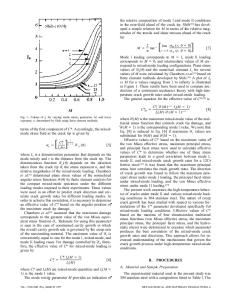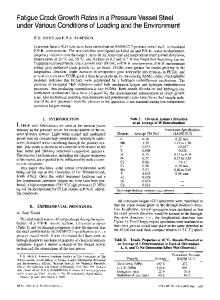High-temperature crack growth in 304 stainless steel under mixed-mode loading conditions
- PDF / 794,916 Bytes
- 11 Pages / 612 x 792 pts (letter) Page_size
- 63 Downloads / 345 Views
I.
INTRODUCTION
A number of investigations of mode I crack growth under creep conditions have been reported.[1–7] These studies have led to several insights into the nature of high-temperature crack growth in metals and alloys and a capacity for predicting crack growth rates. For example, it was established that the time-dependent parameter C(t) and the approximately equivalent Ct correlate better with crack growth rate than many other parameters and may be used to predict the rate of mode I crack growth.[4,5,6] The value of C(t) may be approximated by
~
C(t) 5 1 1
!
t1 C* t
[1]
where t1 is the characteristic time for the transition from an elastic crack tip stress field to one controlled by steadystate creep deformation.[4] It is noted that C(t) becomes equal to the J integral rate parameter C* upon the onset of steady-state conditions. It has been shown that, in addition to being dependent on C(t), crack growth rate is controlled by the nature and size of the crack tip damage zone.[3,6] Hyde and Chambers[8,9] conducted crack growth experiments in which mixed-mode and mode II loading conditions were imposed using the compact mixed-mode specimen geometry. They reported both crack direction and crack growth rate results for different mixed-mode and mode II conditions and compared them with data for conventional compact tension specimens under mode I loading. In general, they found that crack growth rates differed sub-
stantially under different loading modes for the same effective value of C*. More recently, a hypothesis was proposed by the present authors[10] for this discrepancy, suggesting that the development of crack tip damage is strongly dependent on the mode of applied loading. This hypothesis is supported by results from investigations of creep rupture and grain boundary cavitation under multiaxial stress states.[11–15] In order to examine the effect of loading mode on crack tip damage mechanisms, it is necessary to determine the stress states in the vicinity of the crack tip and how they affect the deformation and damage mechanisms governing crack growth. The multiaxial form of the power law describing steadystate creep may be written as 3 εz ij 5 Bs en21 s ij' 2
where B and n are constant for a given material and temperature, se is the von Mises equivalent stress, and s'ij are the deviatoric stresses. After the creep strain exceeds the elastic strain ahead of the crack and steady-state conditions hold, C(t) becomes equal to C*, which is path independent. Although this transition is dependent upon stress state, geometry, and temperature, it is often observed to occur before sufficient damage has incubated to begin crack propagation.[4,5] This damage incubation is typically exhibited by creep-ductile engineering alloys (εf . 10 pct). The mixed-mode form of the path independent contour integral for a creeping body containing a crack is C*k 5
W.E. CHURLEY, formerly Graduate Student, Department of Materials Science and Engineering, University of California, is Engineer, McDonnell Douglas Aerospace,
Data Loading...











